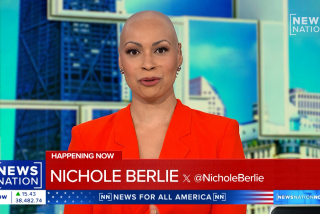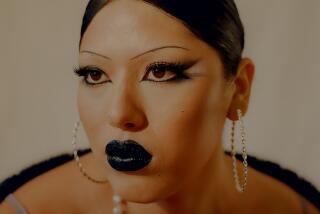Brush up on better hair days
- Share via
We all expect our skin to change with the decades. But who knew that time takes a toll on our tresses in much the same way? While some changes are inevitable, some are the result of the insults we hurl at our hair every day: coloring, curling, straightening, taut ponytails. Want to make the most of what you’ve got? A few tips:
--
The 20s
Your crowning glory
This is as good as it gets: The 100,000-150,000 strands that cover your scalp are the healthiest they’ll ever be. “Most damage at this age comes from experimentation with color and using too much heat,” says Rona O’Connor, a Beverly Hills-based stylist who tends to the lush locks of celebrities, including Blake Lively and Brooke Shields.
Still, there’s no time like the present to start taking care of it. For starters, eat right. Healthy hair depends on vitamins and minerals, especially biotin (a B vitamin), zinc, iron, folic acid, vitamins A, C, E, and, most important, protein. “Hair is made of a special protein called keratin, and if you don’t get enough protein in your diet, it can affect the normal hair cycle,” says Dr. Paradi Mirmirani, a member of the faculty of the American Academy of Dermatology who is based in Vallejo, Calif. Women need about 46 grams a day; during pregnancy and breastfeeding intake should boost to 71 grams. Men ages 19 to 70 need 56 grams of protein a day.
Each hair grows out of a follicle, a tiny sac-like hole in the skin. At the bottom of each follicle lives a cluster of cells that make up the root of the hair. As the root grows longer, it produces the shaft of hair that emerges from the scalp. “The shaft is what we wash and dry and curl or straighten into submission,” says Mirmirani, a hair-loss specialist. The shaft is also dead, which is why it’s difficult to repair it once it breaks or the ends are split.
Healthy hair grows about 1 centimeter a month, called the “anagen” phase. At any one time the majority of our hair is actively growing in this phase, which lasts for two to eight years. When this stage comes to its genetically predetermined end, follicles go into a two-week “catagen” or transitional phase when the follicle shrinks, causing the hair to stop growing. From there, the follicle goes into the resting or “telogen” phase. This final stage lasts for up to four months, until the hair falls out and the cycle starts again.
--
The 30s
Pregnancy takes a temporary toll
Every day we shed up to 100 hairs. But during pregnancy every follicle is in “grow” mode and normal fallout halts. This explains why many women notice their hair is unusually thick during these months. All good things must come to an end, and within a few months of the baby’s birth, the normal cycles resume and you shed every strand that you’ve been holding on to. “It’s certainly alarming to see all that hair in the bathroom sink, but it’s completely normal,” says Dr. Amy McMichael, professor of dermatology at Wake Forest University.
Other possible causes of hair loss in the 30s: significant weight loss, discontinuing hormonal birth control, illness that’s accompanied by high fever, autoimmune disorders and chronic iron deficiency.
“Growing hair requires significant energy,” explains McMichael, “so if your body is stressed in any way, it’s going to divert the attention to where it’s really needed.”
--
The 40s (and beyond) Let the changes begin
If you’ve made it this far with a full head of healthy hair, thank your lucky genes and clean living. “But no matter what, this is the decade when most women notice that their hair starts to look and feel thin and it turns gray,” says Dr. Carrie Jacob, director of Chicago Cosmetic Surgery and Dermatology. “Follicles shrink so the strands are thinner, and we have fewer of them,” she explains. Plus, the number of follicles in the resting and shedding phases increase. Lower estrogen levels are partly to blame.
You can camouflage thinning hair with color (lighter shades reduce the contrast between hair and scalp), fluffy curls or a layered cut to add volume. Or try minoxidil (Rogaine). “It improves the growth rate and the thickness of the hair, no matter how old you are,” says Mirmirani. Some women find the 5% strength irritating but tolerate the 2% well. It takes about six months to get appreciable growth, and the product only works for as long as you use it.
As for the grays, you’ll likely have a few wiry tendrils peeking through now. By age 50, half of women have noticeable gray. Within each follicle lies a certain number of pigment cells that continuously produce the melanin that gives hair color -- right up until they don’t. As we age, the pigment cells gradually die off.
Coloring with semi-permanent tints rather than drying peroxide formulas, and holding back on the heat prevents some damage. Jacob advises using low settings on flat irons and curling irons and says to avoid using them every day. A sealing serum can also protect the cuticle. “Repetitive heat is very damaging.”
--
--
(BEGIN TEXT OF INFOBOX)
--
Tips on washing your hair (or not)
Wash, rinse and repeat, right? Not so fast. By changing your routine ever so slightly, you can enhance the health of your hair, not to mention that sudsing up twice is usually unnecessarily.
-- Wash your scalp, not your hair. Shampoo strips away hair’s natural oils, called sebum, leading to flyaways and dull, coarse hair. Joico’s Clinicure Purifying Scalp Cleanse ($13.95) contains biotin and vitamin B to nourish the scalp as it cleans and removes oil.
-- Wash every other day (or less). Between washes, try a dry shampoo such as Umberto Beverly Hills Dry Clean Shampoo ($8.99) with rice starch to rejuvenate limp hair.
-- Once a week, use a serum. A serum such as Phyto’s Revitalizing Serum contains gingko biloba and vitamins B5 and B6 to stimulate the scalp, improve thickness and slow down the graying process ($33 or more)
--






